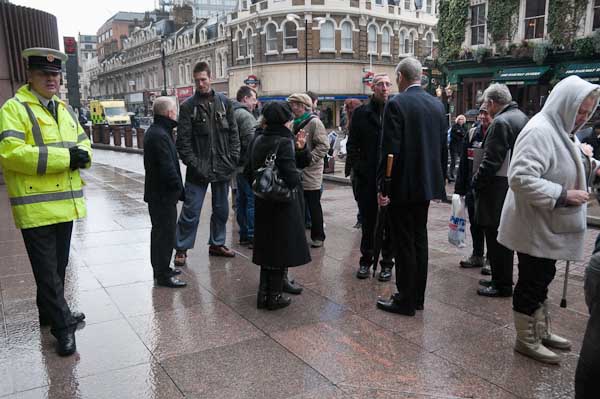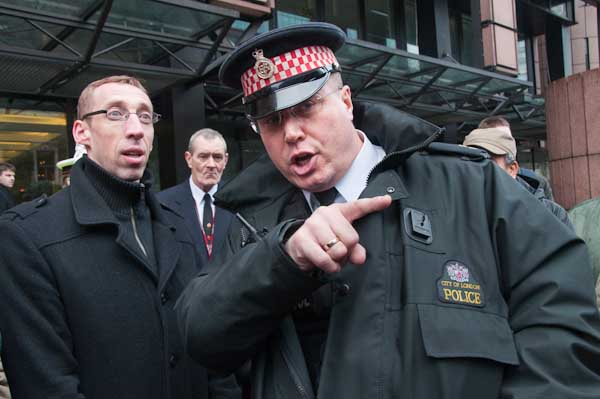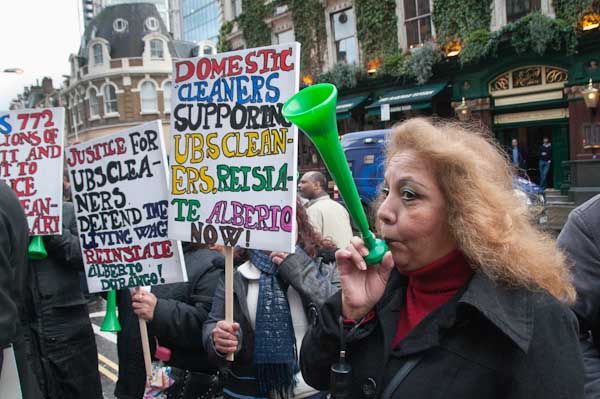Last Friday lunchtime I was photographing a demonstration in the City of London, in front of a large modern office building close to Liverpool St station. The building houses UBS, a Swiss-based company formed by the 1998 merger of the Union Bank of Switzerland and the Swiss Bank Corporation, the second-largest manager of private wealth assets in the world and the second largest bank in Europe according to Wikipedia.
It’s also a company that is trying to bolster its reputation following a continuing investigation into dodgy off-shore accounts designed to fool the US tax authorities, and last month it issued a new code of conduct and business ethics which all employees are required to sign. Apparently the new interest in ethical conduct doesn’t apply to its own relations with cleaners, and it handed over the cleaning contract to a new company, Lancaster, on Feb 1. They immediately cut the cleaners hours – and thus their pay – and sacked the union shop steward, Alberto Durango.
The UBS offices have a wide pavement area in front of them, generally walked across by the public but actually owned by UBS – the kind of privately owned public space that makes up large areas of our cities now. UBS is on the southern edge of the large Broadgate estate which is one such area, developed on the former site of Broad St station (which was of course part of the publicly owned British Rail before it was sold off.) The public are freely allowed onto such areas as consumers to visit and consume the services of the various companies that occupy them, but we are not allowed the freedoms that we normally enjoy on the public highway – such as free speech and taking photographs.
To me this is reflects a deficiency in our planning processes – which should insist on such pavements being a part of the public highway as a condition of planning consent and also possibly of our laws about what is and is not public space. Photographers recently demonstrated at Canary Wharf against the restrictions on photographing there – another large private estate on formerly public owned land.
So I wasn’t at all surprised after I took this picture

that the security guard at the left – his boss is the guy with the umbrella talking to some of the demonstrators telling them they can’t demonstrate there – came up and told me I was not allowed to take photographs. And of course when I asked him why this was, his reply was totally predictable. “Security, this is a bank” he told me. “But I’m pointing my camera away from the bank” I replied, “so how is security involved?” His answer was to tell me that if I continued to take pictures there he would call the police and ask them to remove me, although he did also tell me that I could photograph from the pavement by the side of the road – which would of course mean that I was actually photographing the bank. Somehow that wasn’t a problem.
Of course it isn’t really about security at all. It’s about asserting the rights of the property owner, and also on this occasion about the embarrassment of the company at having a demonstration about the truly abysmal way they are treating their cleaning staff.

What I think is more serious about this is that within a few minutes the police did arrive, not to deal with me, though several times officers did politely tell me to move back onto the public pavement when I strayed on to the private forecourt, but to force the protesters to move off of private land. I fail to see that a peaceful protest on private land that is causing no damage, is of limited duration and no threat to public order should be of any concern to the police. It seems to me to be essentially a civil matter rather than a criminal one, and that the police force have rather more important things that should occupy them.

I’d be very much happier with a police force that acted to protect the rights of workers.
More pictures from the event on My London Diary.